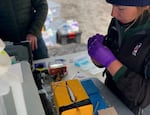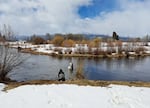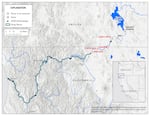
Alexandra Wampler, a PhD student at UC Davis, prepares an acoustic tag for a young Chinook. The fish are anesthetized so they don’t move or feel any pain.
Erik Neumann / JPR
The operating theater is simple: sponges; a few instruments; and what looks like a foam yoga block.
Rachelle Tallman, a graduate student in wildlife, fish and conservation biology at UC Davis, places a small fish — a juvenile spring Chinook salmon — into the ovoid depression on top of the block. Working quickly but carefully, she uses a scalpel to make a small incision along the fish’s belly, then gently places a lentil-sized object — an acoustic transmitter — into the incision.
“356 Delta,” Tallman says, reading the number off the tag. Then she starts suturing.
Tallman is working in the parking lot at Oregon Department of Fish and Wildlife’s Klamath Fish Hatchery near Chiloquin, Oregon. Two colleagues help record data and supply her with fresh fish that are dosed with an anesthetic.
There’s a small crowd gathered on this cloudy April day: biologists and technicians from ODFW, the Bureau of Land Management, Bureau of Reclamation, and California Department of Fish and Wildlife; staff from the Klamath Tribes and Trout Unlimited; students from UC Davis and the University of Oregon.
The effort is part of a collaborative project being led by ODFW to release young Chinook into the upper portion of the Klamath watershed. The fish were brought here from the Trinity River Hatchery in California as fertilized eggs, in 2021.
Three surgery stations are set up side by side; over the next two days, crews will insert acoustic transmitters in 730 fish. Despite the scene’s festive vibe, Shahnie Rich, restoration project manager for the Klamath Tribes, is all business as she expertly ties a surgeon’s knot. It’s her second year on the project.
“It’s a little scary at first once you first start, but you kind of get into a rhythm,” says Rich.
A plastic tube gurgles water over and through the fish’s gills as she snips the excess thread from the salmon’s belly. The goal is to have it back in water as soon as possible.
In another week, most of the fish will be released in the Williamson and Wood rivers above Upper Klamath Lake.
“What we’re trying to do is mimic a hypothetical out-migration of juvenile spring run Chinook salmon from the tributaries of Upper Klamath Lake,” says Mark Hereford, Klamath Fisheries reintroduction biologist for ODFW. Tallman’s acoustic tagging is just one component of the study, now in its second year. It marks the first time Chinook salmon have inhabited the upper basin in more than 100 years.
At one time, the streams and wetlands of the upper basin teemed with fish that made the journey from the Pacific Ocean to spawn: spring Chinook, but also fall Chinook, coho salmon, steelhead and Pacific lamprey. The construction of four hydroelectric dams on the main stem of the Klamath River effectively eliminated those species from the top of the watershed. The dams are coming down sometime next year, opening the door to hundreds of miles of potential habitat.

Lottie Riddle and Carlie Sharpes, Hydrologic Technician and Aquaculturist with the Klamath Tribes, release young Chinook salmon into the Wood River above Upper Klamath Lake.
Juliet Grable / JPR
Fall Chinook, coho and lamprey are commonly seen below Iron Gate, the lowest of the four dams, and biologists expect they will find their way back on their own. But the only significant populations of spring Chinook are found in the Salmon and Trinity rivers, hundreds of miles from the cold, spring-fed streams of the upper Klamath Basin.
“Because those source populations are so far downstream, we’ve recommended more of an active reintroduction strategy, where we might have to assist the repopulation by moving juveniles into the system,” says Hereford.
The fish they’re tagging now don’t represent an official reintroduction, but rather an experiment to see where they go and how well they survive. What they learn could not only help biologists pick the best places to release fish once the dams do come out, but will inform where to enhance and restore habitat.
Through the gauntlet
The upper Klamath Basin sprawls over 5.6 million acres, a complex of spring-fed rivers, wetlands, and shallow lakes. Upper Klamath Lake alone is 25 miles long. How do researchers track six-inch fish through such vast and varied territory?
In part, by using several different tracking technologies. This year, ODFW will release around 8,000 young spring Chinook in the upper basin. While only 700 fish will carry acoustic transmitters, all of them have received Passive Integrated Transponder, or PIT tags, which work like the scannable microchips put in pet dogs and cats.
Each technology has its pros and cons. Acoustic telemetry is useful for learning how fish fare as they move through a river. The transmitters, which cost $250 each and are powered by hearing aid batteries, emit a high-frequency “ping” every 10 seconds, which is picked up by any nearby receiver. If fish are detected at point A and point B but not at point C, you can assume something happened to them between the last two points.
One urgent question biologists are trying to answer is how the young Chinook will navigate warm, shallow Upper Klamath Lake, which is prone to large algae blooms in summer. Will they move through quickly, before it gets too warm? Will they linger too long and suffer, like the two species of endangered sucker fish that live in the lake, or will they behave like redband trout, seeking out cold pockets and getting fat on aquatic insects?
Last year’s results offer some intriguing clues. In spring of 2022, Tallman tagged about 1,100 fish. Most of them left the Wood and Williamson rivers quickly, and while some were soon detected at Link River dam, at the bottom of Upper Klamath Lake, what happened to the rest was something of a mystery.
The batteries on Tallman’s acoustic tags died after about three months. But that summer, PIT tag readers detected some juvenile Chinook in Pelican Bay, a small lobe at the northwest end of Upper Klamath Lake. Several fishermen angling there called Hereford to tell him they’d caught something they’d never seen in the upper basin before: young spring Chinook.
“I’m curious: Are the majority of the fish over-summering, hiding out in these cold water areas?” says Tallman. “Or are they dying in the lake?” To help answer this question, Tallman has placed receivers in Pelican Bay this year.
Hereford says the variable habitats could be the key to salmon’s success in the Upper Klamath Basin.
“You know, it’s very unique: We have warm water habitats, cold water habitats,” he says. “And if they’re utilizing all those different types of habitats, that’s great; that’s what we want. We want lots of diversity.”

The Klamath Basin. Four dams along the Klamath River will be removed in the coming years. The Keno and Link River Diversion dams will remain in place.
California Water Science Center / US Geological Survey
Other obstacles
As soon as fish exit Upper Klamath Lake, they must traverse two dams that have fish ladders: the Link River Dam at the bottom of Upper Klamath Lake, and the Keno Dam, which forms Lake Ewauna on the edge of Klamath Falls. These dams are not part of the Klamath Hydroelectric Project and will not be removed.
A radio telemetry study, initiated last year by Cal Poly Humboldt, has allowed the partners to track young Chinook as they navigate these dams. Estimated survival is “decent,” says Hereford.
“The next question is, how are they getting through the dams? Are they going down the fish ladders? And then we can start thinking about, OK, how can we improve that passage downstream?” The partners are also anxious to learn if adult salmon can make it up these same obstacles.
Salmon will face other challenges as they head down river: unscreened diversions; predation by birds and other fish; and outbreaks of C. shasta, a disease organism that thrives in warm rivers. But once the dams are gone, the Klamath watershed will become a 10 million-acre living laboratory. There will be an epic opportunity to learn about how salmon and other fish respond to the removal of the physical barriers and subsequent changes in flows and water temperature.
PIT tagging will play a large role. In the upper basin, Hereford is relying on PIT readers deployed by the U.S. Geological Survey to track endangered suckers, but ODFW and their partners plan to add more. Below the dams, tribes and federal and state agencies have been using pit tags to monitor salmon for over a decade.
The technology has only gotten better and cheaper, says Hereford. “We can tag tens of thousands of fish in a couple of days.”
Ultimately, the goal is to have a continuous network of PIT readers throughout the entire Klamath watershed. The tags don’t rely on batteries, so they can last “forever” — or at least as long as the life of a fish. Conceivably, it will be possible to track a salmon smolt from a gravelly bar in the Williamson River all the way down to the Pacific Ocean and back again, as a spawning adult.
“We’ll be able to take the lower basin program and upper basin program, combine them, and have one big database,” says Hereford. “It’s going to be super cool.”
Following the fish
On April 12, one week after the acoustic tag surgeries, Hereford, Tallman, and Rob Roninger, a fish biologist with the Bureau of Land Management, truck the tagged Chinook north from the hatchery to the Wood and Williamson rivers, two major tributaries that drain into Upper Klamath Lake.
Two staff from the Klamath Tribes are already there, waiting, as Tallman trudges through slushy snow and sticks a thermometer into the river.
“Five point seven degree Celsius,” she calls out. “That’s close enough.”
Hereford stands next to the tank, transferring netted fish into buckets full of river water. One by one, the small crew haul the buckets to the bank and wade into the frigid but gentle current. Willows, mustard yellow and still bare, stand out against the snow, and in the distance, snowfields on the blue peaks are a welcome contrast to the year before, when the upper basin withered in drought.
The release feels like part task, part ritual. The bucket bearers gently tip their fish-filled containers sideways until they are partially submerged and level with the river. Before long, 350 fish have darted downstream to their new lives. The exercise is repeated on a bend of the Williamson River, just north of Chiloquin.
“I feel good that they’re released,” says Tallman. “We’ll come back in a few weeks and download the receivers and make sure they’re working.”
The acoustic receivers record every sound they hear, so Tallman will have to filter through all of the data to find the unique frequencies associated with her fish. If last year’s pattern holds, she’ll detect the most movement immediately after the release.
These fish are pioneers, helping researchers hone in on the opportunities and the obstacles, knowing that in just a few years, young spring Chinook introduced here will have the chance to trace ancient migratory pathways all the way to the ocean.
Other partner organizations in the Chinook study include NOAA, US Fish and Wildlife Service, Cal Poly Humboldt, Oregon State University, Oregon Department of Fish and Wildlife, The Klamath Tribes, Trout Unlimited, California Department of Fish and Wildlife, US Bureau of Land Management, US Bureau of Reclamation, US Geological Survey, UC Davis and private landowners.